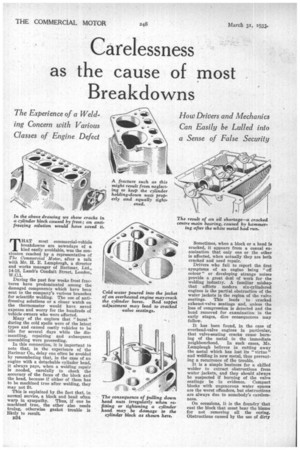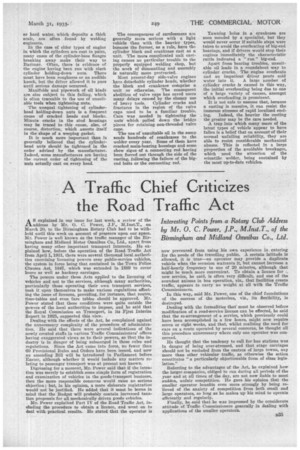Carelessness
Page 48

Page 49

If you've noticed an error in this article please click here to report it so we can fix it.
as the cause of most Breakdowns
THAT most commercial-vehicle breakdowns are nowadays of a kind easily avoidable, was the conclusion reached by a representative of The Commercial Motor, after a talk with Mr. H. E. Lamplough, a director and works manager of Barimar, Ltd., 14-18, Lamb's Conduit Street, London, W.C.1.
During the past few weeks frost fractures have predominated among the damaged components which have been sent to the company's various branches for scientific welding. The use of antifreezing solutions or a closer watch on the thermometer would have saved expense and worry for the hundreds of vehicle owners who were affected.
Many of the engines that " burst" during the cold spells were of the latest types and caused costly vehicles to be idle for several days while the dismantling, repairing and subsequent assembling were proceeding.
In this connection, it is important to note that, in the experience of the Ilarirnar Co., delay can often be avoided by remembering that, in the case of an engine with a detachable cylinder head, it always pays, when a welding repair is needed, carefully to check the accuracy of the faces of the block and the head, because if either of them has to be machined true after welding, they may not fit.
This is explained by the fact that, in normal service, a block and head often warp in sympathy. Thus, if one be machined true, the other also needs truing, otherwise gasket trouble is likely to result.
3334 Sometimes, when a block or a head is cracked, it appears from a casual examination that only one or the other is affected, when actually they are both cracked and need repair.
Drivers who fail to report the first symptoms of an engine being "off colour" or developing strange noises provide a great deal of work for the welding industry. A familiar mishap that afflicts modern six-cylindered engines is the partial obstruction of the water jackets in the region of the valve seatings. This leads to cracked exhaust-valve seatings and, unless the loss of compression is detected and the head removed for examination in the early stages, dire consequences may follow.
It has been found, in the case of overhead-valve engines in particular, that valve-seating cracks cause burning of the metal in the immediate neighbourhood. In such cases, Mr. Lamplough believes in cutting away the metal which has lost its "virtue" and welding in new metal, thus preventing a recurrence of the trouble.
It is a simple business for a skilled welder to extract obstructions from water jackets, and they should always be suspected if burning of the valve seatings be in evidence. Compact blocks with ungenerous water spaces are the worst offenders, but obstructions are always due to somebody's carelessness.
On occasions, it is the foundry that cast the block that must bear the blame for not removing all the coring. Obstructions caused by the use of dirty or hard water, which deposits a thick scale, are often found by welding engineers.
In the case of older types of engine in which the cylinders are cast in pairs, many cases of the cylinder-base flanges breaking away make their way to Barimar. Often, there is evidence of the engine having been run with slack cylinder holding-down nuts. There must have been roughness or an audible knock, but the driver allowed it to pass until serious damage occurred.
Manifolds and pipework of all kinds are also subject to this failing, which is often traceable to the use of unsuitable tools when tightening nuts.
The unequal tightening of cylinderhead holding-down nuts is a frequent cause of cracked heads and blocks. Minute cracks in the stud housings may be traced to this cause, also, of course, distortion, which asserts itself in the shape of a weeping gasket.
It is much more important than Is generally believed that the cylinderhead nuts should be tightened in the order advised by the manufacturer. Indeed, some manufacturers are having the correct order of tightening of the nuts actually cast on every head. The consequences of carelessness are generally more serious with a light vehicle than with the heavier types, because the former, as a rule, have the cylinder block and crankcase cast as a unit. The more complicated unit casting causes no particular trouble to the properly equipped welding shop, but the work of dismantling and assembly is naturally more protracted.
Most present-day side-valve engines have detachable cylinder heads, whether the block and crankcase comprise a unit or otherwise. The consequent abolition of valve caps has saved users many delays caused by the clumsy use of heavy tools. Cylinder cracks and fractures in the region of the valve caps used to be a familiar trouble. Care was needed in tightening the nuts which pulled down the bridge pieces for retaining non-threaded valve caps.
The use of unsuitable oil in the sump sends hundreds of crankcases to the welder every year. Some of them have cracked main-bearing housings and some show signs of a connecting rod having been forced out through the side of the casting, following the failure of the bigend bolts or the connecting rod. Yawning holes in a crankcase are soon mended by a specialist, but they would never occur if suitable steps were taken to avoid the overheating of big-end bearings, and if drivers would stop their engines immediately the characteristic rattle indicated a "run" big-end.
Apart from bearing troubles, unsuitable oil leads in a -roundabout way to cylinder cracks. The engine overheats and an impatient driver pouts cold water into it. A large number of cylinder cracks is caused in this way, the initial overheating being due to one of a large variety of causes, amongst which overloading is prominent.
It is not safe to assume that, because a casting is massive, it can resist the immense stresses of rapid localized cool_ ing. Indeed, the heavier the casting the greater may be the care needed.
A trap into which many users of the latest types of vehicle appear to have fallen is a belief that on account of their normal unfailing reliability, they are able to resist considerable mechanical abuses. This is reflected in a large proportion of the avoidable breakages, which need the attention of the scientific welder, being sustained by the most up-to-date vehicles.




























































































